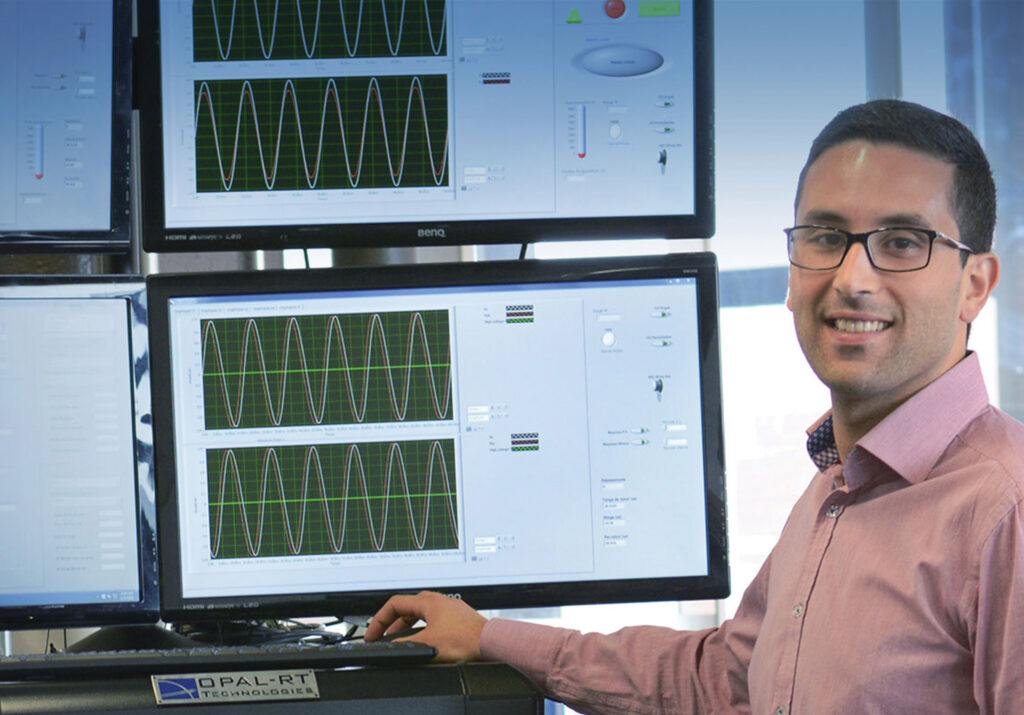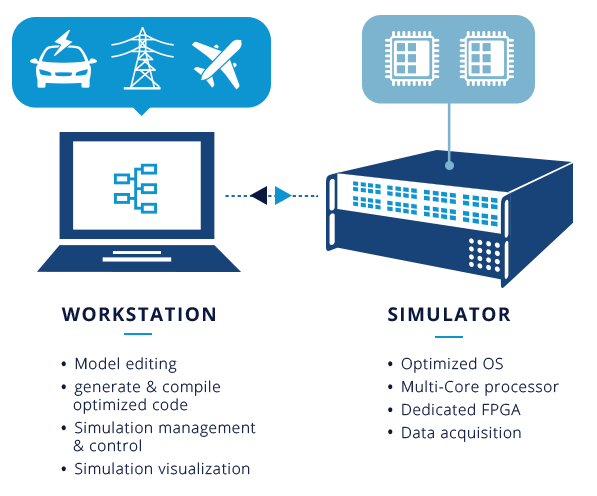Simulation acceleration
Despite major processor advancements, running complex simulations can still mean waiting hours for results. Our simulation acceleration technology uses the full capacity of multi-core architectures to significantly reduce simulation time, especially for computationally intensive tasks like electromagnetic transient (EMT) simulations. By optimizing every step of the simulation process, from code generation to parallel execution, we enable engineers to validate models faster, test more design variations, and move projects forward with greater efficiency using acceleration simulation.

A smarter approach to system testing
What is accelerated simulation?
Accelerated simulation refers to the ability to execute large, highly detailed Electromagnetic Transient (EMT) simulations significantly faster than traditional real-time or offline simulation speeds. This method is a central part of simulation acceleration for high-performance engineering workflows.
Accelerated simulation is especially critical for:
- Transient stability assessment (TSA) of grids with high IBR penetration.
- Hardware-in-the-loop (HIL) testing with real controller hardware.
- Wide-area monitoring, protection, and control (WAMPAC) system design and validation.
- Development of high-fidelity digital twins for online stability analysis.
- Cloud-based simulation and scalability for very large network studies.
| Offline EMT simulation | Accelerated / parallel EMT simulation | Real-time simulation | Quasi real-time or faster-than-real-time simulation |
|---|---|---|---|
| with Generic control models | SIL with real-code controller emulation | HIL with control system replicas | Digital Twin for operation |
| • Typical EMT • Plant level equipment stress evaluation | • DER integration studies • Interaction studies • OEM controller model validation | • Protection and control design and testing • Pre-commissioning tests • OEM controller model validation | • Transient security assessment/contingency analysis • Connected to system state estimator to determine initial state every 5-10 min |
| Enabled with parallel HPC-based real-time simulator technology | Enabled with parallel HPC-based real-time simulator technology | Enabled with parallel HPC-based real-time simulator technology |
Solution
Run faster than real-time
We offer scalable, accelerated simulation solutions for power systems, EMT, and other high-demand applications. On both high-performance Intel/AMD simulators and local workstations, our tools support faster-than-real-time execution without compromising model fidelity. Users benefit from flexible modeling environments like RT-LAB and HYPERSIM, advanced solvers, and efficient automatic code generation—all supporting high-speed execution through simulation acceleration and parallel processing.

Benefits
Simulate faster. Develop smarter.
Accelerated simulation reduces time-to-results and boosts productivity with every iteration. Our high-speed simulation workflows support engineers from design through validation by enabling high-fidelity, real-time computation.
01
Faster verification
Simulate complex EMT models using our multi-processor architecture and Intel/AMD-based platforms.
02
Maximum data accuracy
Leverage our optimized automatic code generation to detect design flaws earlier in development.
03
Test infrastructure reusability
Record all simulation data and reuse test sequences across projects, improving efficiency and consistency.
04
Real-time extension
Seamlessly transition accelerated models to real-time with Hardware-in-the-loop for ultra-precise testing.
Applications
Used across industries
Simulation acceleration is a critical tool in any domain where control, protection, or monitoring systems are developed. It’s trusted by engineers, researchers, and educators to de-risk testing and accelerate innovation.

Energy
Validate protection, stability, and integration of renewables

Power electronics
Test converters, inverters, and power systems dynamically

Automotive
Develop EVs, battery management, and driver-assist systems

Aerospace
Simulate flight control, avionics, and propulsion systems

Academia and research
Enable cutting-edge education and innovation

Autonomy
Accelerate the development of autonomous vehicles and robots with real-time sensor simulation and co-simulation tools
FAQ
Find the answers to your questions
What communication protocols do you support?
Consult our comprehensive list of supported protocols here: Communication Protocols.
What is simulation acceleration, and why is it important?
Simulation acceleration is the process of dramatically speeding up complex simulations, allowing engineers to obtain results in minutes instead of hours. We leverage multi-core architectures and optimize every stage of the simulation pipeline to ensure that computationally intensive tasks, like EMT simulations, are completed faster and more efficiently. With our simulation acceleration capabilities, teams can validate designs quicker, iterate more often, and bring their innovations to market sooner.
How does OPAL-RT’s acceleration simulation solution enhance performance for EMT simulations?
Our acceleration simulation solution is specifically designed to handle the heavy computational demands of electromagnetic transient (EMT) simulations. By automatically generating optimized code and executing it in parallel across multiple processors, we drastically reduce simulation time. This means that our users can simulate seconds of real-world behavior in just a fraction of that time, making our acceleration simulator a critical tool for grid stability assessment, WAMPAC design, and high-fidelity digital twin development.
What types of projects benefit most from acceleration simulation?
Acceleration simulation is especially valuable for projects requiring transient stability assessments of grids with high inverter-based resource (IBR) penetration, hardware-in-the-loop (HIL) testing with real controller hardware, and the development of wide-area monitoring and protection (WAMPAC) systems. We also see significant benefits when using acceleration simulation for creating online digital twins and performing cloud-based studies of large, complex networks.
Can we run simulation acceleration solutions on both OPAL-RT simulators and standard PCs?
Yes, our simulation acceleration technology is designed to be highly flexible. Whether engineers are using our high-performance Intel or AMD-based simulators or running simulations on their own workstations, we enable faster-than-real-time execution without sacrificing accuracy. Thanks to tools like RT-LAB and HYPERSIM, along with powerful automatic code generation, we make it easy to experience the full benefits of simulation acceleration on a wide range of platforms.
What makes your approach to acceleration simulation different from traditional methods?
Unlike traditional simulation methods that can be bottlenecked by sequential processing and slower solvers, we optimize every phase—from model preparation to parallel execution. Our acceleration simulation approach leverages high-speed multi-core computing, advanced numerical solvers, and scalable cloud integration to ensure that users can simulate large systems at unprecedented speeds. By combining hardware flexibility and advanced software environments, we help our customers achieve simulation acceleration without compromising model fidelity.
